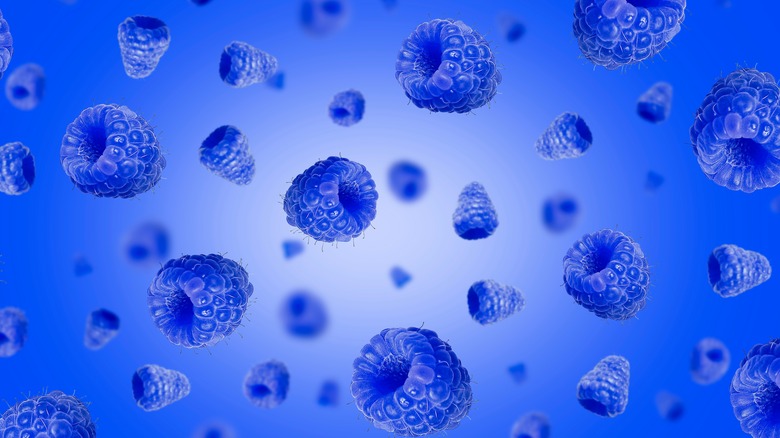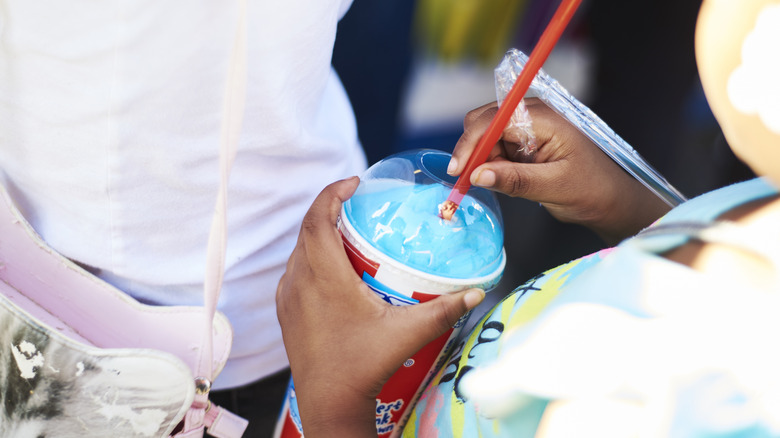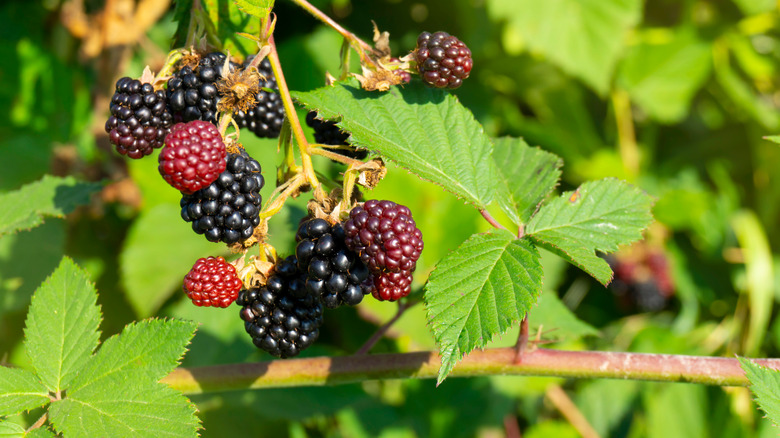Blue Raspberry Flavoring Probably Isn't What You Think It Is
Have you ever wondered why raspberry-flavored candies are blue? It seems like every other flavor has a clear correlation to its color — cherry is red, grape is purple, sour apple is green, and orange is ... well, you know — but the logic ends at raspberry. Instead of trying to match the bright red color that you find in nature, makers of raspberry-flavored confections have opted for a shade of blue that might best be described as radioactive Smurf, and the resulting flavor and color combination called blue raspberry is used in all manner of candies, drinks, and snacks.
No artificial flavoring actually tastes like the thing it is trying to be, but because it so flagrantly violates Mother Nature's color palette, blue raspberry feels like the most overtly artificial of them all. While other flavorings have clear real-world inspirations, you never see actual blue raspberries at the store, leaving the nature of this flavor a complete mystery to most.
You've probably guessed that blue raspberry flavor isn't made from actual raspberries, but most candies don't include any real fruit. Instead, they are flavored with artificial chemicals called esters that mimic natural aromas. Since smell plays a bigger role in our perception of flavor than taste, merely introducing these scents is enough to create a fruity illusion. But there isn't an ester specifically for raspberry, so the flavor is typically made from a combination of cherry, banana, and pineapple esters. This explains why blue raspberry-flavored products don't taste like raspberries, but even then, why color it a shocking shade of blue?
Raspberry flavoring used to be red
Artificial flavors came into use in the mid-19th century, but there was a problem: too many red flavors. Strawberry, cherry, watermelon, and raspberry all had to compete within the same color palate. In order to make these flavors visually identifiable, manufacturers came up with variations that we still see today. Cherry is dark red, strawberry is light red, and watermelon is pink.
The original color for raspberry was a pinot noir hue derived from a dye called amaranth (named after the amaranth grain). Amaranth is also known as Red Dye No. 2, and like other artificial dyes, it's primarily made from petroleum. Beginning in the 1950s, concerns arose that Red 2 could be carcinogenic, and some companies began phasing it out of their products. This is when blue raspberry began popping up, first mentioned in a 1958 edition of The Billboard, wherein Gold Medal, a maker of snow cone and cotton candy machines, advertised a "new blue-raspberry flavor."
In 1976, the FDA banned Red 2, and blue became the standard color for raspberry flavoring. The two brands that led this trend were ICEE and Otter Pops, both of which debuted popular blue raspberry products in the '70s. The standard blue raspberry color we know today is Blue Dye No. 1, which is permitted by the FDA, but still controversial. Though it has not been linked to cancer, the Center For Science in the Public Interest warns that Blue 1 could contribute to in vitro nerve damage.
Blue raspberries are a real thing, but they're nothing like the candy
Blue raspberry products don't taste anything like fresh berries, so it might shock you to know that the flavor is purportedly inspired by a real-world source. Shockingly, when artificial raspberry flavorings were first invented, their inspiration did not come from the common red raspberries seen in most grocery stores, which have the scientific name Rubus idaeus. Instead, they were inspired by Rubus leucodermis, otherwise known as the white bark raspberry, blackcap raspberry, and western black raspberry. This rather uncommon wild berry is native to Western North America, and while you might be able to see the flavor connection, the colors don't line up at all.
The white bark raspberry is as close to an actual clue raspberry as you'll ever find in nature, though it is a far cry from the neon hue of an ICEE or a Jolly Rancher. When ripe, these berries lie somewhere between dark blue and purple. It can be hard to get your hands on the "real blue raspberry" though, as Rubus leucodermis typically isn't grown commercially for food. Believe it or not, its main commercial use is as a dye, albeit one with a much more natural appearance than the blue raspberry candy it inspired.


